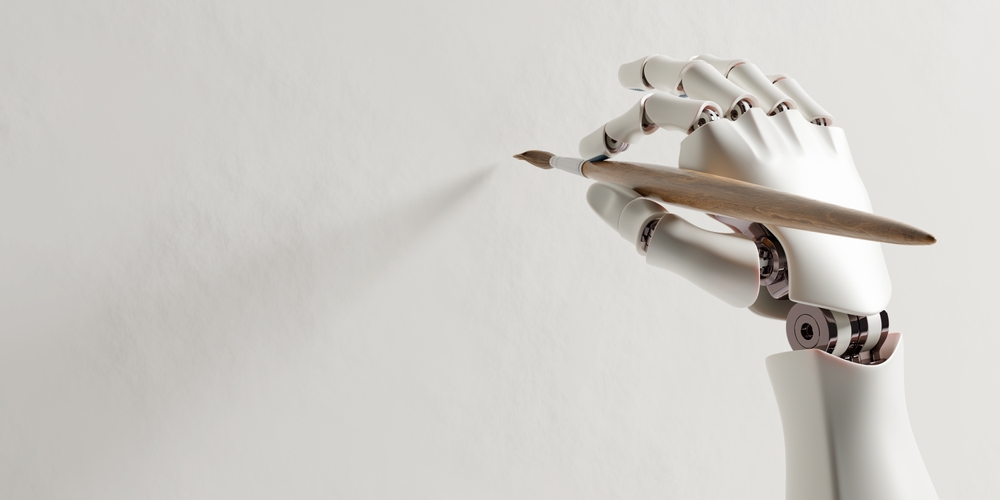Unlocking Creativity – How to Create AI Images
Would you like to listen to this article?
Click here to access our AI-generated audio version! Have fun listening 😉
Unlocking Creativity – How to Create AI Images
Have you ever wondered how AI can be utilized to not only transform leadership development, but also other spheres such as art? Our L&D Consultant Florian Bidermann recently had the pleasure of attending an AI Lab session by artist Bella Volen on “Creating images with AI.”
Until then, my attempts to generate images with AI had not been particularly successful—they were uninspired and unsuccessful. Thanks to Bella’s course, however, I have now gained some eye-opening insights into designing images with AI, which I naturally want to share with you.
Prompting the Visual
First of all, it is quite easy to create unique visuals with just a few prompts. But if you prompt very simply, such as „Create a picture with a tree and a house,” it is more than possible that the result will differ greatly from the picture you desire.
As AI models are trained on vast datasets of images and captions, they generate pictures that match the description. It’s a creative process, but it also requires experimenting—users must invest time to understand the model’s logic and fine-tune requests for optimal results.
Understanding image creation with AI requires a grasp of visual language. The more you are familiar with composition, color harmony, and symbolism, the more the results correspond to the expectations. Learning to express concepts visually is essential for effective AI image generation.
5 Tips When Prompting an Image
Visual language is a language without limits that is dynamic, but follows some clear rules. Here are some of the most important aspects to consider when prompting an image:
- Clearer Communication with AI: Visual language provides the vocabulary needed to create precise, descriptive prompts. The more effectively you can express ideas visually, the more likely you are to achieve the intended result from the AI.
- Improved Results: Knowledge of elements such as balance, contrast, and focal points enables you to guide the AI toward visually harmonious and compelling images. Detailed familiarity with artistic terms helps you specify exactly what you want—like “dramatic lighting,” “minimalist design,” or “complementary colors.”
- Efficiency in Experimentation: If you have a strong visual vocabulary, you can iterate faster. It helps you to adjust styles, moods, or compositions in your prompts, shortening the trial-and-error cycle.
- Contextual Awareness: Understanding visual conventions lets you match image style and content to the intended message or audience.
- Quality Control: You can critically assess and refine AI outputs based on artistic principles, rather than relying purely on technical capability.

Here are some key aspects of visual language that enhance AI image quality that might help you when you are prompting:
Composition
- Arranging elements in the image for balance, focus, and clarity.
- Specifying concepts like “centered portrait”, “rule of thirds”, or “dynamic perspective” helps the AI craft more visually appealing outputs.
Color Theory
- Directing mood and harmony through careful use of color palettes.
- Prompts mentioning “complementary colors”, “warm tones”, or “monochrome” significantly influence the emotion and coherence of the result.
Lighting
- Describing lighting types (“soft lighting”, “dramatic shadows”, “golden hour”) is crucial for depth, atmosphere, and realism.
Style and Genre
- Referring to well-known art movements (impressionism, cubism, manga) or commercial styles (minimalist, photorealistic, vintage).
- Precise style cues lead to outputs closer to the intended vision.
Texture and Detail
- Dictating the level of detail or surface finish (smooth, grainy, painterly, highly detailed) enables tailored results.
Subject Placement and Hierarchy
- Communicating which objects or figures are focal points and how supporting elements are arranged (“foreground emphasis”, “background scenery”, “isolated subject”).
Symbolism and Visual Metaphors
- Using Imagery that carries meaning or evokes specific concepts, such as peace (doves), innovation (lightbulb), or adventure (open road).
Key Takeaways
Anyone can generate visuals with AI, but mastering visual language yields better results. The process is iterative—experimentation and clear prompts are crucial. Be mindful of copyright issues in your creations. Since AI models are often trained on existing artworks, it remains important to consider authorship and intellectual property when publishing or selling AI-generated images.
And Now You
What are your experiences in creating pictures with AI? What helps you to create an image with artificial intelligence – and where do you reach your limits?
Share your thoughts with Florian on LinkedIn!

Florian Biedermann
Learning & Development Consultant at MDI
Florian Biedermann is a Learning & Development Consultant at MDI (Management Development Institute) – a global consulting company that offers solutions for leadership development. His focus is on making complex issues understandable and inspiring people to think – and act. Florian previously worked for many years as an author and manager in the e-learning sector, after spending over a decade as a freelance journalist.

